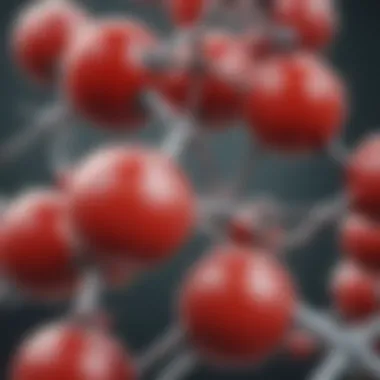Quercetin and Histamine: Their Interactions and Health Impacts


Intro
The relationship between quercetin and histamine is of increasing interest in the fields of health and nutrition. Quercetin is a plant flavonoid widely found in fruits, vegetables, and herbs. It has been studied for its potential effects on various health conditions, particularly in relation to immune responses and allergic reactions. Histamine, on the other hand, plays a crucial role in the body’s immune system but can also contribute to allergic symptoms when released in excess. Understanding the connection between quercetin and histamine offers insights that could influence treatment approaches for allergic conditions, making this a pivotal area of research.
Recent Advances
Latest Discoveries
Recent studies have demonstrated that quercetin may inhibit the release of histamine from mast cells, which are key players in allergic responses. In one study, quercetin was shown to lower histamine levels in response to allergens, suggesting that it may be beneficial for individuals with allergies. This effect is largely due to its antioxidant properties, which can help protect cells and modulate immune responses.
Furthermore, research indicates that quercetin not only reduces histamine release but also increases the expression of enzymes responsible for metabolizing histamine. This dual action may position quercetin as an effective agent in managing allergic reactions, highlighting its therapeutic potential for conditions like hay fever and asthma.
Technological Innovations
Advancements in food technology have also provided innovative ways to enhance quercetin intake. For instance, food scientists have developed methods to increase the bioavailability of quercetin through encapsulation techniques. This can maximize its absorption in the body, making it more effective in modulating histamine levels. Additionally, nutraceutical formulations that combine quercetin with other anti-inflammatory compounds are being explored for their synergistic effects in managing histamine-related disorders.
Methodology
Research Design
Most studies examining the interactions between quercetin and histamine utilize a variety of research designs, including controlled clinical trials and laboratory studies on cellular models. These studies often aim to clarify the mechanisms by which quercetin affects histamine release and its subsequent impact on allergic symptoms.
Data Collection Techniques
Data collection typically involves both qualitative and quantitative methods. Blood samples are often analyzed for histamine and quercetin levels, while participants may complete questionnaires detailing their allergy symptoms. Additionally, in vitro studies evaluate the effects of quercetin on mast cells, providing detailed biochemical insights.
"Understanding quercetin's influence on histamine levels can pave the way for new therapeutic strategies in allergy management."
Through these approaches, researchers continuously refine the understanding of how quercetin can beneficially interact with histamine, aiming to establish clear guidelines for its consumption and application in dietary interventions.
Intro to Quercetin
Quercetin is a naturally occurring flavonoid that holds considerable significance in the context of health and nutrition. Understanding its properties and sources is essential to grasp its potential impact on health and its interactions with histamine. As a bioactive compound, quercetin may help to mitigate various health issues, particularly those linked to allergic responses. This introduction sets the stage for a deeper exploration into quercetin's attributes and its importance in human health.
Definition and Chemical Structure
Quercetin, scientifically known as C150O7, is a flavonoid found in many fruits, vegetables, and plants. It has a distinctive chemical structure characterized by three hydroxyl groups, which contribute to its various biological activities. The presence of these hydroxyl groups allows quercetin to act as a powerful antioxidant, neutralizing free radicals and preventing oxidative stress. This structural feature not only supports health at the cellular level but also enhances quercetin's potential in various therapeutic applications.
Sources of Quercetin
Quercetin can be found in a diverse range of foods, making it accessible to most individuals. Common sources include:
- Onions: Particularly red onions, which contain high concentrations of quercetin.
- Apples: The peels are the most nutritious.
- Berries: Blueberries and cranberries are good sources.
- Green Tea: Known for its antioxidant properties.
- Capers: Surprisingly rich in quercetin content.
Incorporating these foods into the diet may enhance overall health, especially for those sensitive to histamine.
Historical Use in Traditional Medicine
Historically, quercetin has been utilized in traditional medicine for its medicinal properties. Ancient cultures recognized its potential benefits. For example, in traditional Chinese medicine, quercetin-rich plants were often prescribed for their anti-inflammatory and antioxidant effects. Similarly, Native American tribes used plants like the common elderberry for their health benefits, including allergy relief and management of respiratory conditions. These traditions underscore quercetin's long-standing role in natural healing practices, hence its relevance in contemporary health discussions.
Understanding Histamine
Histamine is a crucial compound in the body, particularly recognized for its roles in the immune system and allergic reactions. Understanding histamine is essential, as it can elucidate how interactions with quercetin might influence health, especially in the context of allergies and inflammation. Histamine itself is produced by mast cells and basophils and is involved in various physiological functions, including gastric acid secretion, neurotransmission, and immune responses.
Role in the Immune System
Histamine plays a significant role in the immune system. It is released during immune responses, serving as a signaling molecule that communicates distress. When an allergen is detected, histamine release can lead to various reactions in the body, including vasodilation and increased vascular permeability. This process helps immune cells reach the site of infection or injury. However, excessive histamine release can lead to issues such as anaphylaxis or chronic inflammation.
- Vasodilation: Histamine causes blood vessels to expand, increasing blood flow to affected areas.
- Increased Permeability: Histamine makes blood vessels more permeable, allowing immune cells to infiltrate tissues more easily.
- Signaling: It acts as a neurotransmitter in the brain and can influence cognitive functions.
Several disorders are associated with histamine imbalance, making its understanding vital for health.


Histamine Receptors and Their Functions
Histamine exerts its effects through specific receptors, known as histamine receptors. There are four main types: , , , and , each having unique functions in the body. Understanding these receptors is critical for comprehending how quercetin may interact with histamine-related processes:
- ** Receptors**: Primarily associated with allergic responses. Their activation leads to typical allergy symptoms such as itching and swelling.
- ** Receptors**: Located mostly in the stomach, they stimulate gastric acid secretion and aid in digestion.
- ** Receptors**: Mainly found in the brain, they regulate neurotransmitter release and play a role in cognitive function.
- ** Receptors**: Involved in regulating immune responses, particularly in attracting immune cells to sites of inflammation.
Quercetin's potential as a modulator of these receptors presents an interesting area of study, particularly in the development of therapies targeting allergic and inflammatory diseases.
Histamine's Role in Allergic Reactions
Histamine's involvement in allergic reactions is well-documented. When the body encounters allergens, such as pollen or certain foods, it triggers a series of immune responses that culminate in massive histamine release. This reaction aims to protect the body but often results in symptoms that can be uncomfortable or even dangerous.
- Common Symptoms: Sneezing, itching, swelling, and difficulty breathing.
- Pathophysiology: The binding of histamine to receptors leads to the manifestation of these symptoms by affecting blood vessels and nerve endings.
The connection between quercetin and histamine could play a role in allergy management. Quercetin may help stabilize mast cells, reducing histamine release and consequently alleviating allergic symptoms.
Understanding histamine and its mechanisms is fundamental for developing effective treatments for histamine-related disorders. This knowledge drives research toward innovative therapies that incorporate natural compounds such as quercetin.
The Interaction Between Quercetin and Histamine
Understanding the interaction between quercetin and histamine is crucial in both immunology and clinical applications. Histamine plays a critical role in allergic reactions and the immune response, while quercetin, as a natural flavonoid, provides potential benefits in managing conditions influenced by histamine levels. This section will explore various aspects of their interaction, detailing the mechanisms through which quercetin influences histamine, and its implications for health.
Mechanisms of Action
The mechanisms by which quercetin acts on histamine involve complex biochemical pathways. Quercetin can inhibit the enzyme alpha-glucosidase, which plays a role in the release of histamine from mast cells. This inhibition reduces the amount of histamine that enters circulation during an allergic response.
Moreover, quercetin alters the expression of histamine receptors, particularly and receptors, diminishing the sensitivity of tissues to histamine. This modulation can result in less pronounced allergic symptoms. Recent studies have shown that quercetin's ability to stabilize mast cells leads to a reduced risk of anaphylactic responses, indicating its potential as a therapeutic agent in allergy management.
Influence on Histamine Release
Quercetin's influence on histamine release forms a core part of its interaction with histamine itself. Several experimental studies suggest that quercetin can inhibit the process of degranulation in mast cells. This process is where mast cells release substances like histamine in response to allergens.
Specifically, quercetin exerts its effects by blocking calcium influx into mast cells. Calcium is essential for the degranulation process. By preventing calcium from entering the cells, quercetin effectively reduces the secretion of histamine into the body and minimizes the severity of allergic reactions. Research indicates that incorporating quercetin-rich foods may be beneficial for individuals with high histamine responses.
Inhibition of Histamine Activity
Once released, histamine acts on various target tissues, inducing symptoms such as inflammation, redness, and swelling. Quercetin offers a multifaceted approach to inhibit histamine activity. This flavonoid competes with histamine for binding sites on its receptors, potentially blocking its action on target cells.
Additionally, quercetin has anti-inflammatory properties that further mitigate the effects of histamine. By reducing inflammation, quercetin can alleviate symptoms associated with allergies and histamine intolerance. Its role in regulating inflammatory mediators shows promise in managing chronic conditions linked to excessive histamine release.
"Quercetin does not remove histamine from the body but rather moderates its effects, making it a crucial ally for those dealing with histamine-related health issues."
In essence, the interaction between quercetin and histamine is significant and multifaceted. Understanding these interactions can empower individuals to make informed dietary choices, potentially improving their health in the context of allergies and inflammatory diseases.
Potential Health Benefits of Quercetin
Quercetin, a bioactive flavonoid found in various fruits and vegetables, offers multiple health benefits. Understanding how it works can lead to better health management. This section delves into its prominent effects: antioxidant properties, anti-inflammatory effects, and its role in allergy management.
Antioxidant Properties
Quercetin functions as a potent antioxidant. Its molecular structure allows it to neutralize free radicals in the body. Free radicals can cause oxidative stress, leading to chronic diseases like cancer and cardiovascular issues. Through scavenging these unstable molecules, quercetin helps maintain cellular health and integrity.
Research indicates that high quercetin intake may lower the risk of conditions related to oxidative stress. Fruits such as apples and berries, and vegetables like onions and kale, are rich in quercetin. Incorporating these into one’s diet can be beneficial.
"Antioxidants play a crucial role in protecting the body from cellular damage."
Anti-Inflammatory Effects
Another significant benefit of quercetin is its anti-inflammatory properties. Chronic inflammation is linked to various health issues, including arthritis, diabetes, and heart disease. Quercetin modulates the inflammatory pathways in the body, providing symptomatic relief.
Studies have shown that quercetin can inhibit the production of pro-inflammatory cytokines. This makes it a valuable addition for those seeking natural anti-inflammatory strategies. By reducing inflammation, quercetin helps improve overall health.


Role in Allergy Management
Quercetin's ability to manage allergic reactions is notable. It is known to stabilize mast cells, which release histamine during an allergic response. By inhibiting histamine release, quercetin may alleviate symptoms of allergies.
People often use quercetin supplements during allergy season. Many studies support its effectiveness in reducing cough, nasal congestion, and other allergy-related symptoms. Natural food sources like citrus fruits, capers, and black tea can also help in managing allergies due to their quercetin content.
In summary, these potential health benefits exemplify quercetin's role in promoting well-being. From combating oxidative stress to managing inflammation and aiding allergy relief, this compound holds significant health implications.
Clinical Applications of Quercetin
The clinical applications of quercetin are significant due to its wide range of health benefits. Research shows that this flavonoid can play a critical role in managing various health conditions. Its effects on the immune system, particularly concerning histamine, make it a relevant subject for further exploration. Understanding these applications not only assists healthcare professionals but also informs patients seeking alternative or complementary therapies.
Quercetin in Allergy Treatment
Quercetin is well-known for its potential in treating allergies. Studies indicate that quercetin acts as a natural antihistamine, helping to stabilize mast cells and prevent the release of histamine during allergic reactions. This mechanism is crucial for individuals suffering from seasonal allergies or food sensitivities, as it may reduce symptoms like sneezing, itching, and inflammation.
A systematic review in 2020 evaluated the clinical effectiveness of quercetin for allergy relief. The findings suggest positive outcomes in symptom reduction when incorporated into treatment protocols. Moreover, its anti-inflammatory properties may further alleviate the discomfort associated with allergic reactions.
This natural approach may interest those who prefer to avoid synthetic medications, particularly antihistamines that may cause drowsiness or other side effects. However, while quercetin shows promise, it should be considered as a complementary therapy rather than a standalone treatment, especially for severe allergic responses.
Impact on Respiratory Conditions
Quercetin's role extends to respiratory health. With conditions such as asthma and chronic obstructive pulmonary disease (COPD) on the rise, understanding the implications of quercetin becomes critical. The flavonoid has demonstrated anti-inflammatory effects in respiratory tissues, which may support individuals with these conditions. It can help reduce airway inflammation and improve overall lung function.
In one study, subjects who supplemented with quercetin reported improvements in pulmonary function tests compared to placebo groups. The mechanism may involve the inhibition of inflammatory markers in the lungs and decreased oxidative stress. This presents a potential pathway for quercetin as an adjunct to conventional medication in managing respiratory symptoms.
Quercetin in Other Health Issues
Beyond allergies and respiratory conditions, quercetin holds promise in addressing various health challenges. Its antioxidant properties are linked to a lower risk of chronic diseases such as cardiovascular issues, diabetes, and even some forms of cancer. By combating oxidative stress, quercetin may help maintain cellular integrity and support overall health.
Research focusing on metabolic conditions suggests that quercetin can improve insulin sensitivity and reduce total cholesterol levels. Moreover, its impact on gut health, involving the modulation of gut microbiota, could provide further benefits, especially considering the critical connection between gut health and overall well-being.
Quercetin is a multifunctional flavonoid that does not only target allergy management but also supports respiratory function and guards against chronic diseases.
The multifaceted applications of quercetin make it a compelling topic for ongoing research. As we gain further insight into its mechanisms and health benefits, quercetin may emerge as a valuable tool in contemporary medicine.
Dietary Sources of Quercetin
Quercetin stands out as an essential flavonoid present in various foods. Recognizing the dietary sources of quercetin is significant in the context of health management, especially concerning allergic reactions. This section elaborates on how different fruits, vegetables, and supplements can serve as practical sources for this compound, shedding light on the implications for overall well-being.
Fruits and Vegetables Rich in Quercetin
Many fruits and vegetables contain notable amounts of quercetin. Some of the richest sources include:
- Onions: Particularly yellow and red onions, offer a high concentration of quercetin. The skin, often discarded, holds the most beneficial compounds.
- Apples: With their skin intact, apples provide a decent amount. Varieties such as Red Delicious or Granny Smith may have higher concentrations.
- Berries: Certain berries, like cranberries, blueberries, and blackberries, are excellent sources, contributing various antioxidants alongside quercetin.
- Leafy greens: Spinach and kale also contain quercetin, making them beneficial additions to salads and smoothies.
- Capers: Not commonly consumed in large quantities, yet they contain some of the highest levels.
Including a variety of these fruits and vegetables in the diet can enhance quercetin intake and contribute positively to health management strategies, especially for those prone to allergies.
Supplements and Their Efficacy
Quercetin supplements are available and are often marketed for their potential health benefits. They are typically sourced from natural plant extracts. Here are some key points to consider regarding their efficacy:
- Bioavailability: The absorption of quercetin when consumed as a supplement can vary. Factors like formulation, presence of other ingredients, and individual digestive health influence how effectively the body utilizes these supplements.
- Dosage: Supplements usually come in varying dosages. It's imperative to adhere to recommended guidelines or consult a healthcare professional for personalized advice.
- Formulation Variety: Many supplements include additional ingredients that could magnify their effects, like vitamin C or bromelain. This combination might enhance quercetin's anti-inflammatory properties further.
While supplements can be beneficial, they should complement a diet rich in natural sources rather than replace them.
Recommended Daily Intake
Determining the adequate amount of quercetin can be complex due to the lack of specific guidelines from health authorities. However, an approximate intake range derived from various studies is:
- Minimum: It's suggested that a daily intake around 500 mg may offer health benefits.
- Maximum: Some studies indicate that doses up to 1000 mg are generally safe, although higher amounts should be approached cautiously.


Incorporating dietary sources can naturally meet these requirements. As always, individual needs may vary based on factors such as overall health, dietary restrictions, or specific health conditions. Monitoring one's response to quercetin, either through diet or supplements, is vital for optimizing its benefits.
"The synergy between natural dietary sources and potential supplements amalgamates to offer comprehensive health benefits that may aid in managing histamine levels and other associated conditions."
Overall, understanding these dietary sources empowers individuals to make informed choices toward enhancing their health through improved quercetin intake.
Considerations and Precautions
Understanding the considerations and precautions associated with quercetin is important for anyone looking to incorporate this flavonoid into their health regimen. While quercetin exhibits many potential benefits, it is crucial to acknowledge possible side effects, medication interactions, and populations that might be at risk. These elements inform safer usage and ensure that individuals can make informed decisions based on their unique health profiles.
Potential Side Effects of Quercetin
Quercetin is generally well-tolerated by most individuals. However, some people may experience side effects. Common side effects can include:
- Gastrointestinal Upset: Some individuals report symptoms like nausea, diarrhea, or stomach cramps after consuming quercetin, especially in high doses.
- Headaches: A few users may experience headaches, which could be linked to the flavonoid's effects on blood vessels.
- Allergic Reactions: Rare instances of allergic reactions have been noted, indicating that individuals with specific sensitivities should proceed with caution.
Although these side effects are not exhaustive, they underline the necessity of starting with a low dose and watching for reactions. Consulting with a healthcare provider is wise, especially for those with preexisting medical conditions.
Interactions with Medications
Quercetin could potentially interact with certain medications. These interactions can influence how medications are metabolized or absorbed, potentially diminishing their efficacy. Notable interactions may include:
- Blood Thinners (Anticoagulants): Quercetin may enhance the effects of medications like warfarin, increasing the risk of bleeding.
- Antihistamines: Since quercetin can influence histamine levels, there may be an alteration in the effectiveness of some antihistamines used for allergies.
- Diuretics: Quercetin might increase the effects of diuretics, leading to dehydration or electrolyte imbalance.
It is essential to discuss all supplements with a healthcare provider, especially if other medications are in use. This ensures a comprehensive viewpoint of how quercetin may influence overall treatment plans.
Populations at Risk
Certain populations may face increased risks when using quercetin. This includes:
- Pregnant and Breastfeeding Women: The safety of quercetin during pregnancy is not well-studied, so it is advisable for these individuals to avoid it unless directed by a healthcare professional.
- Individuals with Certain Allergies: People with sensitivities to plants in the onion family may also react to quercetin, as their chemical structures are similar.
- Those with Chronic Conditions: Patients with chronic conditions should be cautious and consult their healthcare provider before starting quercetin due to its potential impacts on health status.
Incorporating quercetin can provide health benefits, but it comes with considerations. By understanding potential side effects, interacting medications, and high-risk populations, individuals can better navigate their journey in utilizing quercetin safely.
Future Research Directions
The avenue of future research regarding quercetin and histamine interaction holds significant promise. Understanding these interactions can advance our knowledge in various health domains. Increasing attention towards this relationship may unlock novel therapies for conditions aggravated by histamine.
Expanding Understanding of Mechanisms
To navigate the complexities of quercetin’s role, research must focus on the biochemical pathways at play. Quercetin’s ability to modulate histamine activity is intricate. It interacts with histamine receptors and other immune mediators, influencing inflammatory responses. Future studies could utilize advanced techniques such as proteomics and genomics to map these interactions and reveal previously unknown mechanisms. This comprehensive exploration may provide insights that could lead to tailored therapeutic solutions for individuals suffering from allergic reactions and other histamine-related disorders.
Clinical Trials and Their Implications
Clinical trials are crucial in translating laboratory findings to practical applications. Well-structured trials are needed to understand quercetin’s efficacy and safety in diverse populations. For instance, examining dosage variations and the effects of quercetin on different demographic groups can offer nuanced data. Moreover, trials could assess its combined use with other antihistaminic therapies. This research may allow professionals to refine treatment protocols, optimizing patient outcomes and informing healthcare guidelines on managing histamine-related disorders.
Potential for New Therapeutic Applications
The therapeutic landscape could vastly expand through renewed focus on quercetin. Beyond its established uses in allergy management, potential applications in other conditions like asthma, eczema, and even certain cardiovascular diseases merit exploration. Investigating these avenues may lead to breakthrough therapies that utilize quercetin’s multifaceted properties. In addition, understanding the synergy between quercetin and histamine can inspire the development of innovative dietary strategies or supplements aimed at mitigating excessive histamine responses.
Finale
The conclusion of this article serves as a vital reflection on the intricate relationship between quercetin and histamine. It is essential to synthesize the evidence presented regarding how quercetin influences histamine levels and its broader health implications. This understanding is not merely academic; it has tangible benefits for individuals who experience allergic reactions, inflammation, or other histamine-related disorders.
Summary of Key Findings
In summary, quercetin emerges as a potent compound with significant potential in managing histamine's effects within the body. Several key findings are evident from the discussion:
- Quercetin’s Mechanisms: It plays an important role in inhibiting histamine release from mast cells. This inhibition can lead to reduced allergy symptoms in sensitive individuals.
- Health Benefits: Quercetin possesses antioxidant and anti-inflammatory properties, making it beneficial for overall health, particularly in respiratory conditions and allergic responses.
- Dietary Sources: Foods rich in quercetin, like onions, apples, and dark leafy greens, are readily available, encouraging daily incorporation into diets.
These findings highlight that quercetin does not only have an application in supplementary forms, but also as a functional component in daily nutrition.
Overall Significance of Quercetin in Health
The overall significance of quercetin in promoting health cannot be overstated. Its ability to modulate histamine levels opens new avenues for exploring treatment in conditions like allergies and asthma. By understanding the dynamics between quercetin and histamine, professionals in healthcare can better tailor dietary and therapeutic interventions for their patients.
The implications extend beyond allergies, potentially influencing chronic inflammatory diseases. Researchers should continue to investigate the full scope of quercetin's benefits, paving the way for its integration into dietary guidelines aimed at enhancing public health. In summary, quercetin's ability to manage histamine's impact showcases its promising role in health management and disease prevention.















